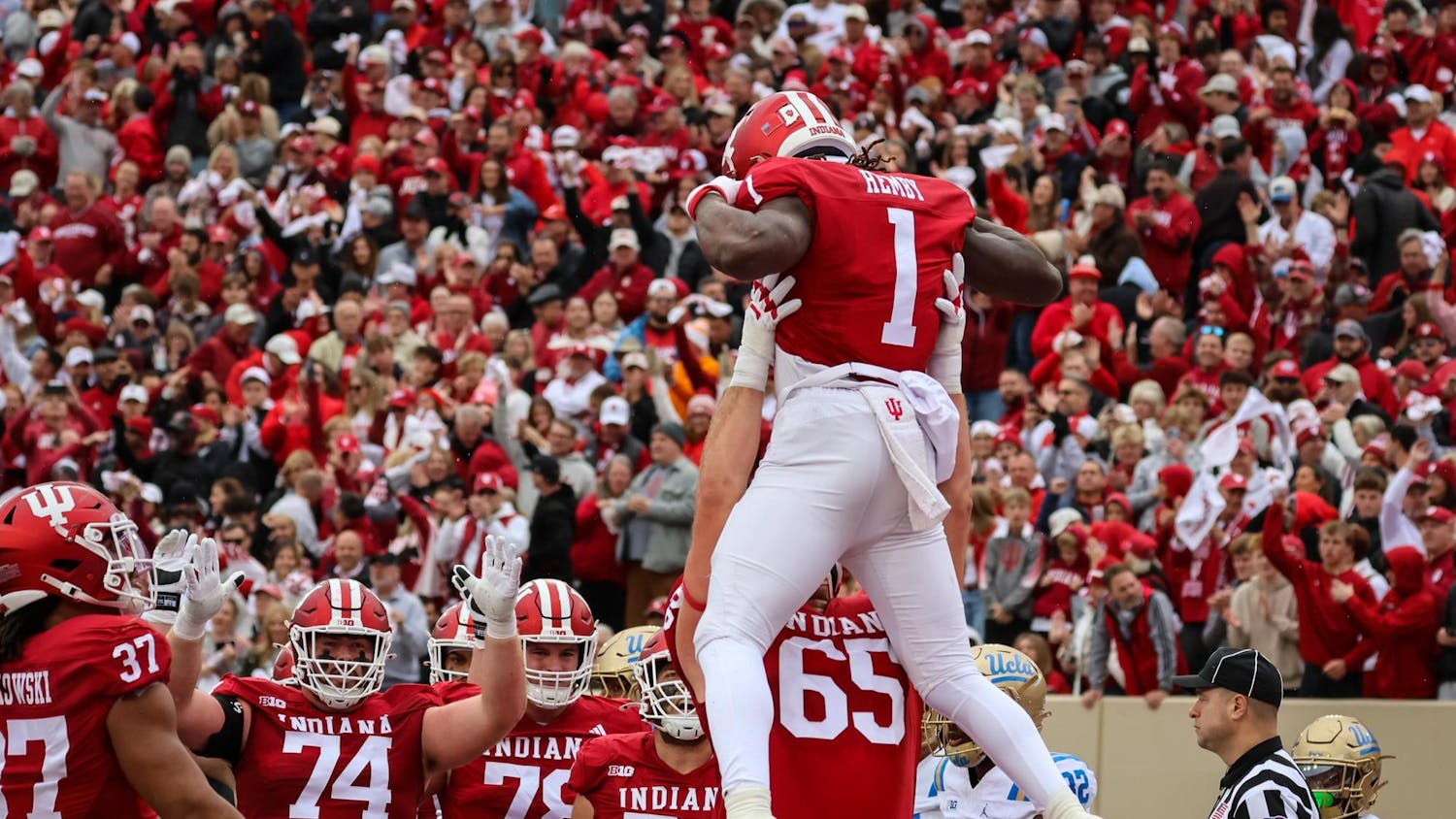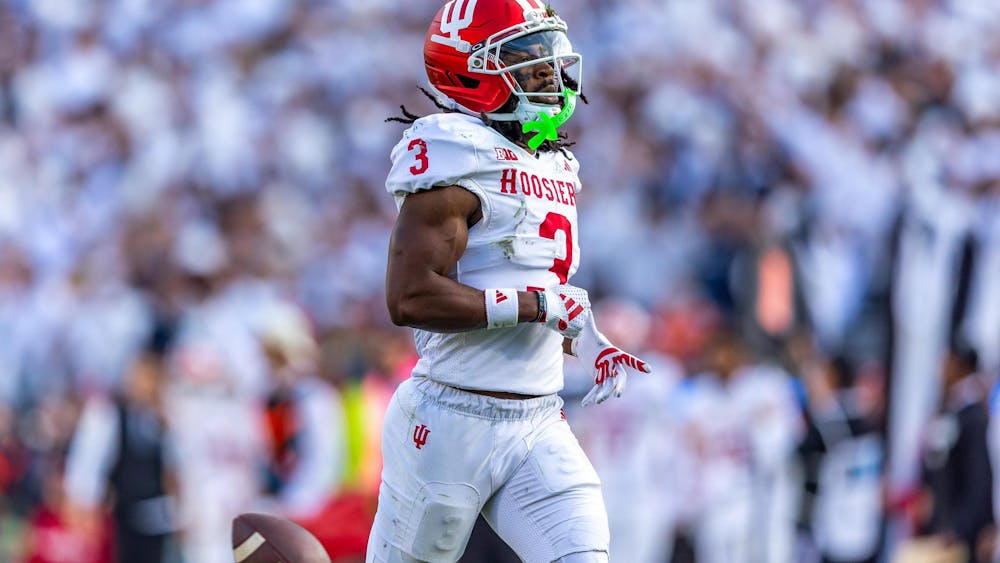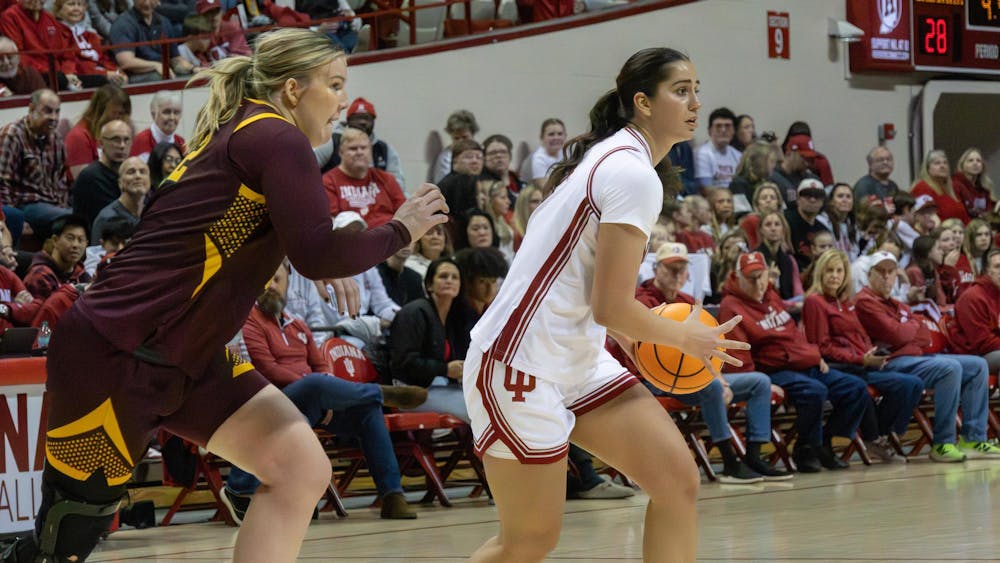When IU women’s soccer players compete at home, they’re surrounded by success — not their own, but that of the men who play on the same field.
Fourteen Big Ten season titles. Eleven Big Ten tournament titles. Eight national championships. Eighteen College Cups. Even the grass beneath their feet, Jerry Yeagley Field, bears the name of the men’s team’s most successful coach.
On Oct. 12, the Hoosier women took on the Iowa Hawkeyes. The team ran onto the field undefeated at home. Crowd members cheered for friends and family. A loyal group of Iowa supporters congregated in one section of the south bleachers.
Four hundred forty-four people came on the Saturday evening to watch the Hoosiers and Hawkeyes.
Three days later, droplets of rain fell on 1,434 people as the men’s team was shut out 3-0 by Louisville.
On average, seven times as many fans have watched the men play at home this season than the women, according to IU Athletics Department data. The men’s budget is 1 1/2 times larger than the women’s. Men’s Coach Todd Yeagley’s base salary is almost twice as much as Women’s Coach Amy Berbary.
In IU’s history, the women’s soccer team has won one Big Ten season title and one Big Ten tournament title, both in 1996, a season the Indiana Daily Student called “surreal” at the time.
This sort of inequity is commonplace in collegiate athletics, not just in the Big Ten but throughout the country.
In June 1972, President Richard Nixon signed Title IX into law. One of the effects of the law, written by Sen. Birch Bayh of Indiana, was a theoretical end to inequity in college sports.
IU is compliant with Title IX, which bans gender discrimination in education but doesn’t set specific requirements for college athletics departments.
“The reality is, Title IX is broad legislation,” said Julie Cromer, executive associate athletics director. “There are three ways to demonstrate compliance with Title IX. We focus on all of those, but any one could be enough to satisfy the law.”
A MEN’S SPORTS SCHOOL
For 41 years, IU has had to meet a legal obligation of equity.
Despite the vague demands of Title IX, athletics department officials hold themselves to a high standard, Cromer said. Every year, they submit compliance documents to the NCAA and evaluate their programs independently.
Are there the same number of positions on teams for both women and men?
Are scholarships distributed equally between men and women?
Is the quality of the experiences and services provided to athletes the same for both sexes?
On paper, these metrics fall within the athletics department’s targets. The gender breakdown of athletic programs is within a few percentage points of the campus enrollment breakdown, according to IU’s Equity in Athletics Disclosure Act documents. Athletes have access to the support and amenities they need, and coaches are paid competitive salaries within their respective sports, Cromer said.
Yet this mathematical equity doesn’t often translate into women’s championships on the court, track, course or field.
As a community, Hoosiers glory in the five national championship banners in Assembly Hall. They wear with pride eight stars on men’s soccer apparel. Those athletic successes help define IU, said Gary Sailes, a sports sociologist and associate professor in the School of Public Health.
“This is a men’s basketball school,” Sailes said. “Sport is a religion. We lead that cultural ideology for the state. Every kid grows up and wants to play basketball for IU.”
Since 1932, IU teams have won 25 national championships: eight in soccer, six in swimming and diving, five in basketball, three in cross country, one in track and field, one in wrestling and one in tennis.
Twelve of those championships came after Title IX became law in 1972.
Only the last one — tennis in 1982 — was won by a women’s team.
That tennis championship was far from the only success in IU’s women’s sports history.
Ten women have won individual national championships, and the women’s swimming and diving team won four Big Ten championships in five years from 2007-2011. Five Hoosier women competed in the 2012 Olympics, and Margaux Farrell was part of a bronze medal-winning French team in the 4x200-meter freestyle relay.
“While we have one team national championship on the women’s side, there have been individual performances that have been pretty spectacular as well,” Cromer said. “We’ve had some pretty phenomenal women come through the program and gone on to win medals and national championships after their time at IU.”
These successes are prominent in IU sports history, but the athletics department hasn’t been able to expand them across more sports to create the sort of tradition of success that exists in men’s sports.
“The history is what it is,” she said. “I don’t think Indiana University was necessarily an outlier in its approach to women’s sports in the past. My sense is that we were very much in keeping with what was going on nationally.”
SOLVING FOR EQUITY
“All they have to do is win.”
That’s what Sailes’s students tell him each year after he instructs his Sport in American Society students to attend a women’s basketball game.
His students all go to a game — they’re free with a student ID — and report back. As a class, they discuss what they saw and how the women’s and men’s games differ.
“Would you go to another women’s game?”
That’s the last question Sailes asks his students after their discussion.
“Yeah, I might,” they say. If the team starts winning.
Since Athletics Director Fred Glass was hired in 2009, the athletics department has prioritized success in women’s sports, embarking on what Cromer called an “aggressive” campaign to hire the best coaches.
“We will not just win and not just compete but win championships,” Cromer said. “What I think is unique about this time in IU athletics history is that we have a real opportunity to make some headway with women’s sports.”
Success in any athletic program requires highly competitive players and highly competitive coaches.
One of the largest roadblocks preventing IU from winning more in women’s sports has been a shallow pool of top players that almost always go to the elite programs. In women’s basketball, schools like the University of Connecticut and University of Tennessee, both of which have eight national championships, have commanded national attention for their success and attracted top players at the same time.
“UConn’s been great because there’s been a thin pool of players, and they’ve been in that pool bringing most of the players to them,” Cromer said.
Sailes said he believes IU will never be on the level of UConn or Tennessee in women’s basketball.
“It’s about the culture of the institution,” he said. “It’s about men’s basketball here.”
But the athletics department disagrees. It sees women’s basketball as a sport ripe for improvement.
The basketball culture of Indiana could easily embrace success in the women’s team as well as the men’s team, Cromer said.
In an attempt to turn around a women’s basketball program that hasn’t played in an NCAA tournament in more than 10 years, the athletics department hired Coach Curt Miller, whose record of success is better than any other women’s basketball coach in IU history, Cromer said.
“We’re very happy with the progress he and his staff have made on the recruiting front here,” Cromer said. “Much of the reaction we’re seeing confirms our notion that there’s a target-rich environment and people who would be interested in coming to Indiana to play women’s basketball.”
Sailes said a couple of successful seasons could completely change fans’ perspective of the team. And in a state where basketball is more a way of life than a game, that could change the whole culture surrounding the sport at IU.
“Winning takes care of everything,” he said. “That’s what my students believe.”
PAYING FOR 24 SPORTS
The IU Athletics Department commands a budget of $70.1 million a year.
That’s more than the
annual budget of the Jacobs School of Music, the School of Public and Environmental Affairs or the School of Education. It’s more than the University spends each year to operate its campuses in Gary, Richmond and Kokomo.
Cut out a little less than half the budget for general operations, facilities and academic support. Take another $13 million to cover scholarships.
What’s left — $23.6 million — funds IU’s 24 sports. It pays for coaches’ salaries, travel, recruitment and office fees. It feeds athletes and provides them with equipment.
When IU Athletics allocates each year’s budget, it focuses on meeting each team’s needs, which means each team won’t have the same expenses as every other team, Cromer said.
“The food bill for our offensive linemen alone is much more expensive than for our entire women’s cross country team,” she said.
There remains, however, a massive discrepancy between the funds available to the men’s basketball and football teams and those available to the remaining 22 sports.
Football and men’s basketball, the revenue sports, will together spend more money this year than every other IU sports team combined. Coaches Tom Crean and Kevin Wilson will each earn a salary higher than IU President Michael McRobbie and could be eligible for $1 million to $2 million in bonuses.
This reflects the income model of the department, which is almost completely self-supporting. Almost 60 percent of the department’s revenue can be tied to men’s basketball and football. Fifteen percent of the department’s annual revenue came from radio and TV contracts for football alone.
Across the board, IU directs its spending to follow market trends. Cromer said the athletics department aims for near the middle of the Big Ten when it makes salary offers for coaches.
“You can pay a very competitive salary to a softball coach that is different from a men’s basketball coach,” she said.
In 2012, Crean earned almost $2.5 million, making him the highest-paid public employee in Indiana. Softball Coach Michelle Gardner made $106,386.
“One of the things that I often say here as we’re planning and preparing budgets for future cycles is that we don’t have to spend money the same way we make money,” Cromer said. “We only have two truly revenue sports here at Indiana.
“That doesn’t mean that we have to spend all our money in the same two sports where we make it.”
A CHANGE OF MINDSET
The sun starts to set on a lazy Bloomington Saturday evening. From her spot in the front row of the bleachers in Bill Armstrong Stadium, sophomore Samantha Feather can see Assembly Hall and Memorial Stadium to the west.
She’s a director on Student Athletic Board, which organizes student sections for every sport. At the women’s soccer game, the student section is small.
Feather said she thinks people have higher expectations for men’s sports than women’s.
“People think they have a more exciting atmosphere and they’re more aggressive,” she said.
Although the Hoosiers lost to the Hawkeyes 2-1, they’re in the middle of one of their best seasons in years. They’ve won 11 games for the first time since 1998.
“I think you have to just completely change mindsets,” she said. “They (were) undefeated at home, women’s soccer. But people still don’t come out to see them.”
Follow reporter Michael Auslen on Twitter @MichaelAuslen.
Despite Title IX, sports’ gender inequity persists
Get stories like this in your inbox
Subscribe





